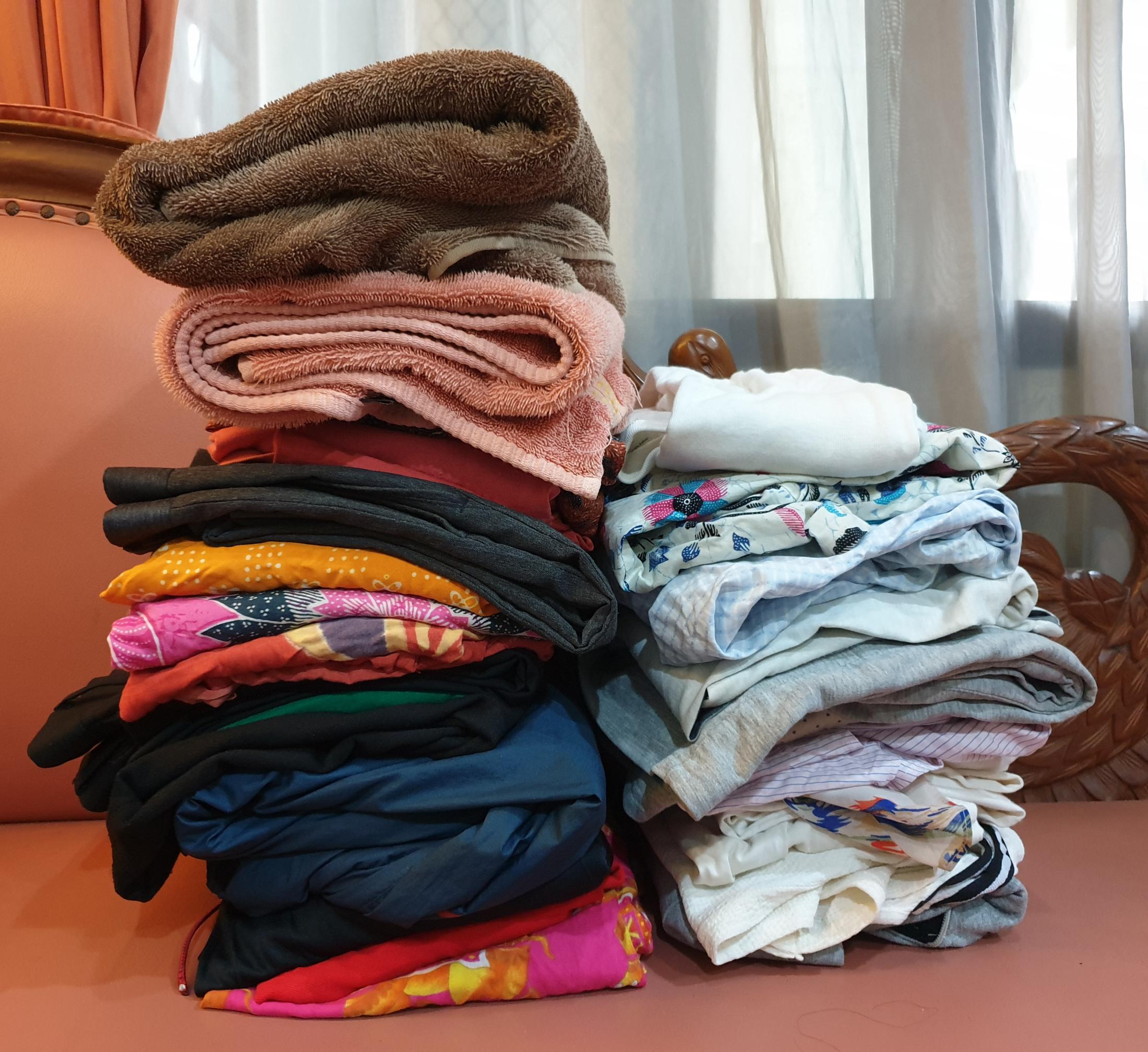Home & Living
Take a More Sustainable Approach to Spring Cleaning With These Handy Tips
Just a few small changes when it comes to cleaning and maintaining your home can make a big impact on the environment.

There may still be a chill in the air, but now is the time to start thinking about that seasonal rite, the spring clean.
Whether you plan to tackle an over-stuffed closet, clear the pantry, or organize the cleaners languishing in the cupboard under the kitchen sink, the season of renewal is the optimal time to take stock and tidy up.
But before you drag out that Swiffer, consider bringing a more mindful approach to this year’s spring clean, one that takes into consideration the sustainability of your home—and the planet.
In the Kitchen
Lisa McCoy, an educator with the University of Maryland Extension (part of the College of Agriculture and Natural Resources and the University of Maryland Eastern Shore that offers statewide educational programs) and a registered dietitian, has been teaching green home courses for years.
She says consumers need to be careful to read what is in the cleaners they use at home and pour down their drains. The Cleveland Clinic notes that antibacterial spray, for example, can contain pesticides, while glass cleaner has irritants like ammonia.
McCoy says many consumers fear that green cleaners will be more costly than their chemical-laden counterparts, but that’s no longer so. While the Environmental Protection Agency (EPA) has lists of approved green cleaners on its website, McCoy suggests getting a reusable spray bottle and simply making your own.
“The three most basic ingredients you need to clean your house are vinegar, baking soda, and water,” says McCoy. “People rely on things with fumes, but that’s just toxic chemicals.”
If you don’t like the idea of cleaning your home with vinegar and water, there are refillable cleaners for both the home and bathroom, like Grove Co.’s cleaning concentrates and Plaine Products refillable bath and shower wares.
McCoy is practically evangelical about food waste, and with good reason. The EPA states that more food waste reaches landfills than any other form of municipal solid waste, and the USDA says we throw out billions of pounds of food a year. If you’re emptying the pantry, don’t be taken in by vague labels.
“Very few things, baby formula is one, have an expiration date,” says McCoy. “Most have a ‘best by’ date and just because you are passed that doesn’t mean the food is no longer good, only that you will get the very best quality from it before that date.”
The USDA states that “best by” and “sell by” dates are not safety dates, nor are they required by law. They suggest using signs of spoilage—an off odor, flavor, or texture—to determine if something is ready for the garbage.
McCoy says that most food waste starts at the store, where we buy too much and in too large a quantity than we could ever consume. But if you’re faced with a refrigerator full of rotting produce, consider composting rather than simply throwing food away.
Food scraps can be tossed into a small bin before being transferred outside to a compost pile—a pile of scraps, leaves, and other materials that gets turned occasionally for aeration until it eventually breaks down into soil. Composting is a safe and effective way to manage organic matter at home, even if you don’t have community composting available in your neighborhood.
All the scrubbing that goes into cleaning goes through plenty of paper products. Americans use a lot of paper towels, and the amount is growing. Research suggests 51,000 trees per day are required to replace the number of paper towels that are discarded every day. Instead, use reusable cloths or cut up old T-shirts to upcycle them into useful rags.
An investment McCoy believes everyone should make is good food storage containers (she gifted them to her family this year for the holidays). These include string bags for bringing home produce rather than using flimsy, plastic bags provided by the store, and reusable storage containers and silicone bags for everything from lunch snacks to leftovers rather than plastic baggies and wrap.
While her family looked askance at this holiday gift, once she explained how it would keep single-use plastics out of landfills and waterways, they were onboard.
Plastic, even that which we put in a recycling bin, is difficult and expensive to repurpose, which is why studies indicate perhaps as little as five percent of it actual gets recycled. Reducing your home’s reliance on single-use plastic could be the greenest change you make this spring.
While you’re in the kitchen, rein in one of its largest energy hogs: the dishwasher. While many are far more efficient with water than ever before—often using less water than handwashing—the heat cycle to dry dishes really adds to your carbon footprint. Green your dishwashing clean by using the air-dry option found on newer models or simply crack open the door when the wash cycle is finished.
“These seem like little things, but you’d be surprised the difference they can make if everyone did it,” says McCoy.
In the Bathroom
Most of us were taught as kids to conserve water by not running your tap while you brush your teeth. And showers are typically more water efficient than baths. Yet the bathroom is a vortex of plastic waste. Just peek at how many plastic bottles of shampoo, conditioner, and body wash are crammed in your shower and you can understand why the bathroom is an excellent place to green your spring clean.
In her book Go Gently, Bonnie Wright (better known as Ginny Weasley of Harry Potter fame and now a green living advocate) admits that the bathroom was an intimidating prospect.
“When I started to lower my use of single-use plastic packaging, I was overwhelmed with all the products that I owned but never used, have used just once, or had small trial packages of,” she writes.
When she conducted her bathroom edit, Wright came up with a list of easy swaps to make the bathroom greener. First, she switched to shampoo, conditioner, and body soap bars packaged in paper. Shampoo and conditioner bars are available online through places like the Package Free Shop, but many local salons and stores now carry them, like Mt. Royal Soaps in Remington. She also switched to a bamboo toothbrush rather than a plastic one, though there are also great aluminum options, too, with replacement heads.
Another easy swap is conventional toilet paper for the stuff made from bamboo, a more sustainable material than traditional woods, or recycled toilet paper. If you’re concerned about finding a reputable brand, look for products with trusted third-party certifications, such as the Forest Stewardship Council (FSC). While not as luxuriously soft as some toilet papers, these products, particularly bamboo sheets, which are made from long fibers like traditional toilet paper, can be quite cushiony.
As Wright alludes to, the bathroom can be rife with tiny bottles—trial-size shampoos, empty cosmetic containers—many of them plastic. Programs like those offered by Terracycle may help with the sustainable disposal of these items, which are often difficult to recycle because of their small size.
In the Laundry Room
The laundry room is rife with chemical cleaners and masses of water waste. Just consider the size of the single-use plastic jugs of laundry detergent taking up space in your laundry area, not to mention the chemical-laden, single-use dryer sheets. But new efforts at sustainability have really cleaned up the room that, for many, is one of the busiest in the house.
“A variety of products have been introduced that help to reduce single-use plastic packaging, including reusable dryer balls, dissolvable cleaning tablets you dilute in water, and plastic-free dishwasher pods sold in cardboard boxes,” says Wright, who uses Dropps cleaning products for her wash.
It’s not just what we wash our clothes with that matters, but how. Always run full loads and lower your water temperature. EnergyStar research shows that washing clothes in cold water significantly reduces a home’s carbon footprint and is gentler on fabrics. Another boon to the environment and fabric fibers? Forgoing the dryer and using a drying line or rack instead.
According to Green America, “in many households, the dryer is the third-most energy-hungry appliance, after the refrigerator and washer. Air-drying your clothes can reduce the average household’s carbon footprint by a whopping 2,400 pounds a year.”
The Last Word
Helping your green home stay sparkling and clean while reducing your impact on the environment requires more than just using all-natural cleaners—it takes a change of mindset. It requires becoming a thoughtful consumer and making a concerted effort to consume less.
By purchasing less food that will go to waste, less clothing that never gets worn, and fewer cosmetics that languish on a bathroom shelf, you are doing your part to have a tidier home and a cleaner earth. Many of these changes aren’t just a choice—they may soon be law. Baltimore County, for example, is proposing a ban on single-use plastic bags like laws already on the books in the city and Howard County.
In her book, Wright says the goal is to make changes at home that allow for progress, not perfection. “This journey is not about getting rid of everything and starting again in order to adopt a perfect ‘sustainable lifestyle,’” she says.
“No matter what we do for a living or for fun, each of us spends a significant amount of time in our home. It is liberating when this important space begins to reflect and represent our values.”
The Sustainable Closet Clear Out
Springtime is often a time to clear out closets and get rid of unwanted or unworn items. While dropping things at a charity donation center is certainly better than chucking old items in the landfill, Americans generate so much textile waste that it can overrun the capacity of those shops. As much as 11 million tons of textiles end up in the trash each year in the U.S.
Ashley Ingraham Watts, owner of the organization company Home Perspective says, “I think it’s important to donate to locations that you know will be putting items donated to use.” She adds that you should organize your donations and label them with the contents. “The easier you make it for the donation locations to sort and get on the shelves, the better.”
Here are some of Ingraham’s favorite local donation destinations:
• Renewal Upscale Resale at Hunt Valley Town Center: A resale boutique that takes clothing, accessories, cookbooks, small housewares, and collectibles. All proceeds benefit Johns Hopkins Hospital.
• Ruth’s Closet in Owings Mills: A resale boutique that accepts clothing and accessories. All proceeds benefit House of Ruth.
• Maryland Book Bank: Perfect for books of all ages and varieties.
• Maryland SPCA: Will accept old towels, flat sheets, and blankets to use for their animals.
• Scrap BMore: Accepts spare craft materials, fabrics, yarn, buttons, and more.
